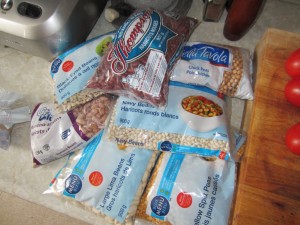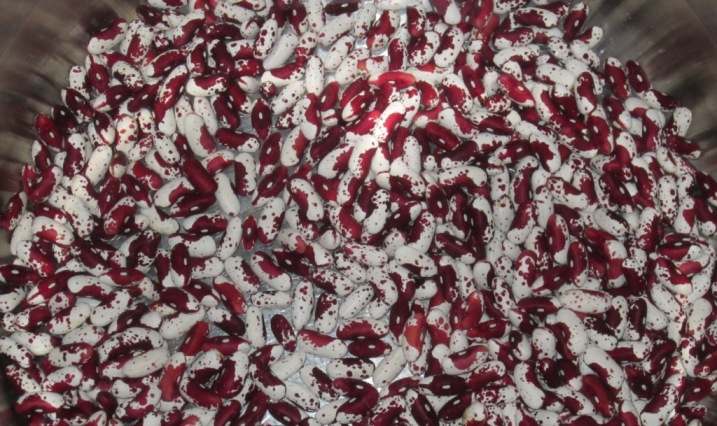Imagine my shock. Shock I tell you! When a well known cookery show recently proclaimed to all the world that “canned beans are just as good as dry” one of my culinary foundations was shaken to the core. I had heard this from ‘shortcut chefs’ in the media far too often but having done my own tests years earlier, dismissed them as bean lunatics only after the convenience factor. It does take time to cook dry beans but the upper plateau of bean superiority I inhabit says that if you can’t plan a day ahead, you don’t deserve good beans. You should always cook beans from dry, right?
But this new champion of canned is well-respected and steeped in methodical testing. How could they have come to such obvious bean voodoo conclusions I asked myself? Their case is made on the fact that factory bean cooking technology has come a long way in the past few decades. OK, I get that. Cars are more efficient. The internet is faster. Maybe someone down in the research department at Acme Bean Company has really been doing their job well since 1993. They say that texture is much improved and because of the controlled conditions that mere mortals could never hope to reach in their squalid home kitchens, they can deliver a consistent taste with every can.
Suspicious, I had to try the whole of bean testing again for myself. The subjects? Three beans of random choosing. garbanzo, red kidney, and white navy versions. I also tossed in a curious exotic called ‘cranberry’ beans from a local grower (see the photo above) but of course they were only available dried. Seems their trucks don’t know the way to the bean factory, at least not at a price they demand. I scoured the local megamarkets for comparable varieties and splurged on everything from ‘in sauce’ to ‘salt-free’ versions of my test varieties. Name brand and generic. Big cans, small cans, and bag after bag of dried.

Despite the doubters, I fancy myself a pretty darn good bean cook. I spent weeks making all manner of bean dishes from plain to elaborate. I soaked for hours, I soaked overnight, I quick-soaked, and of course I drained cans. I rinsed cans. I attempted every sort of bean permutation an obsessed cook should try. Here’s the conclusion. There are good canned beans out there but they’re expensive. There are also really bad canned beans out there with sometimes tongue-numbing levels of salt. But to be fair, the same can true for dried if you’re a bean rookie in the kitchen.
Simply put, you need to know that your dried beans are fresh. I know it sounds like an oxymoron but they really should be from the most recent year’s crop. Sure they’re edible even five years later in the bottom of your doomsday bunker but we’re talking about the pinnacle of Beantopia here. Old beans cook up to a mealy, grainy texture and will never get tender no matter how long or how hot you stew them in your cauldron. In that same vein, Witch Hazel, you need to start by soaking them slow and cold for a few hours which, when your dry beans are fresh, allows them to plump up properly. Something that old beans don’t do as well and that isn’t as complete with ‘quick’ methods. It’s worth noting that lentils, the tiny cousins of beans, usually don’t need any soaking time.
Afterwards simmer the little devils gently with a bit of salt and only just until tender. Personally I like to err on the firmer side rather than mushy end of the spectrum since I often make a big pot and know there will be reheating in their future. The same applies if your beans are heading into another dish that will get cooked further, say Mexican refried beans or Turkish falafel. The art of the bean is getting the texture right and that’s going to take some practice, some care, and some experience with each sort of bean you tackle.
The expert opinions that made this grandiose quality statement about canned beans did so while glossing over some of the lesser entrants into the great bean debate. You can certainly buy decent canned beans with fair texture but they’re not going to be the cheap eighty-cent Bob’s warehouse club brands *. They’re going to run you at least double that for a gourmet producer who has this methodology down pat. In some cases for more exotic offerings, you can pay nearly $4 a can in my local bean emporiums although you do typically get a really fancy label to impress your vegetarian friends in that bargain.
* I do note that the big box warehouse type stores can be real bargains for ten-kilo sacks of dry beans if you’re feeding a vegetarian army.
And that brings up cost in general. Dried beans, even my fancy local heirloom sorts, max out at around $4 a pound. Usually more like half that cost but let’s split the difference. A pound of beans renders anywhere from six to eight cups of cooked beans compared to a can that typically holds two cups once you get them drained. Let me take a pile of very boring bean math and distill it down for you. Dry beans average about forty cents per cooked cup. Generic canned beans can sometimes be had for about the same.
So, Mr. Spork, what’s your problem? Get on the canned bean bandwagon, right? Not so fast there TexMex. That par comes with high estimates on dried and low on canned. Not exactly comparing limas to lentils, now is it? If your dried beans drop below $3 a pound, you’re ahead with them. If you want quality in a can and have to pay for premium brands to get it, you’re ahead again with dried. And even putting the cash issues aside, here’s the real nail in this canned bean conspiracy’s coffin. Salt.
You’re about to tell me you can get no-salt added beans, right? And that they’re just as cheap as the regular sorts. Who do I think I’m fooling? You’re correct. In a surprise twist for the usually salt-obsessed food factories, you can in fact find no-salt beans all over the place. What you can’t find easily is low salt versions. With the bean canners, it seems like it’s all or nothing down in the bargain price bracket and I say an unsalted adzuki can be just as bad as an over-salted cannellini.
Long ago the myth that you shouldn’t salt beans when cooking them was debunked (the theory was that it made them tough… totally false) and like potatoes or pasta, you need a bit of salt in there to give flavour. Hopefully good sea salt and in just the right amounts. The cheap cans I could find go off the rails on both ends of the track and either use way too much or none at all, both of which give results you can beat at home with only the smallest amount of cooking practice and gentle fingertips in the salt cellar.
So smarty pants test kitchens of the media world, I say balderdash to your new found sensationalized canned bean wisdom. Home cooks can learn how to make dry beans just as well as the factory. And stay in control of the seasonings with equal aplomb. And if they want to save half, two-thirds, or even more of the cost in the process, more bean power to them I say. I won’t hold this misstep against you if don’t look in the back of my pantry where I might have stashed a can or two of the good brands just in case I forgot to start my soak last night. You never know when there might be a bean emergency.

